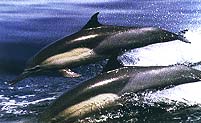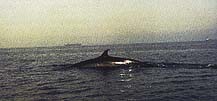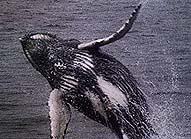AN ARABIAN SECRET
Pictures by Jamie Watts, Joanne Addy & Carol Carson
 Close encounters with whales are not unusual along Oman's rich and varied shores. Together with their cousins, the dolphins, there may be as many as 22 species that inhabit or pass through the seas of the Sultanate. In some areas, it is possible to regularly encounter hundreds of spinner dolphins mixed with schools of common dolphins. Boats become surrounded by a sea alive with dolphins, leaping, spinning, somersaulting and generally frolicking around. Risso's dolphins, false killer whales and perhaps pilot whales may race past, or come in close to bowride. Bottlenose and Indo-Pacific humpback dolphins are regularly seen and exciting, close up views of humpback , Bryde's, sei, minke and sperm whales have thrilled many an avid observer. Fortunate whale watchers could also come across striped and pantropical spotted dolphins, killer whales, pygmy killer whales, blue and fin whales, even dwarf and pygmy sperm whales of the shy Cuvier's beaked whale. There are surely others, such as the finless porpoise, waiting for the first lucky viewer.
Close encounters with whales are not unusual along Oman's rich and varied shores. Together with their cousins, the dolphins, there may be as many as 22 species that inhabit or pass through the seas of the Sultanate. In some areas, it is possible to regularly encounter hundreds of spinner dolphins mixed with schools of common dolphins. Boats become surrounded by a sea alive with dolphins, leaping, spinning, somersaulting and generally frolicking around. Risso's dolphins, false killer whales and perhaps pilot whales may race past, or come in close to bowride. Bottlenose and Indo-Pacific humpback dolphins are regularly seen and exciting, close up views of humpback , Bryde's, sei, minke and sperm whales have thrilled many an avid observer. Fortunate whale watchers could also come across striped and pantropical spotted dolphins, killer whales, pygmy killer whales, blue and fin whales, even dwarf and pygmy sperm whales of the shy Cuvier's beaked whale. There are surely others, such as the finless porpoise, waiting for the first lucky viewer.
Relatively little is known about any of the whales and dolphins around Oman, or for that matter the whole of Arabia. Recent sightings have even suggested the possibility of two species new to science. The reason for the lack of information is, quite simply, that few people are aware of the wealth of whales and dolphins (or cetaceans, as they are collectively called) in the region and fewer still have attempted any serious study. The chance of seeing a dolphin that is yet to be described by science or a whale that is yet to be recorded in the area is an experience that few other locations around the world can offer.
Watch Out for Whale -Watching
Despite this, there are plans to implement whale -watching on a small scale in the near future. This will be done with the initial help of scientists and students who will count, photograph, map and generally gather data on any whales and dolphins that are sighted. Gradually a picture will emerge not only of where the greatest number of whales are, but also of what they are doing and when they are doing it. If, for example, whales are breeding during summer months then to approach them closely at sea may disturb them. This has clear repercussions for the whales and any negative impact on them is deflected directly back to those who are trying to watch them. There is certainly little doubt that Oman has the potential to attract a share of the industry's annual global revenue of over US $ 317 million and to add to the four million people world-wide that venture out to sea every year to watch whales.
Prior to the development of organized whale-watching in Oman, enthusiasts can still join in on the secret. Whales can be seen from land along much of Oman's beautiful coastline. Good vantage points are common where mountains reach the shore as cliffs, and in many areas headlands jut far out to sea. Humpback and minke whales are the most likely to be sighted feeding in shallow waters, and humpback and bottlenose dolphins habitually spend most or all of their time inshore. Far better, however, is to venture out to sea by boat. As there are no commercial whale-watching companies in Oman, this means either joining friends in a privately owned vessel or hiring a fishing boat from one of many opportunistic fishermen in any fishing village along the coast.
 Where and When to Watch
Where and When to Watch
Early mornings and evenings are usually the best times to look for cetaceans, as the sea is often calmer and the light better. They can be found any distance offshore, the majority of sightings so far being close to land. However, small boats rarely venture any distance out to sea and trips further offshore could prove extremely worthwhile. Recently, a pod of sperm whales, numbering over 24 individuals, including young, was sighted in deepwater some distance off Muscat. Fishermen report numerous sightings of what are thought to be false killer whales at a similar distance from land, which, they say, sometimes follow their boats for several hours leaping into the air and riding the bow wave.
Dolphins are easier to find than the bigger whales as they tend to swim in larger groups and surface more frequently. Splashes made by performing dolphins are often the first thing you will see. Some, such as the commonly encountered spinner dolphin, leap over 3 m into the air, before slapping back down onto the water's surface. Fleets of fishing boats may also betray the presence of dolphins as fishermen are known to follow the dolphins in search of tuna (see Vol. 1 No.1). Similarly, flocking seabirds may be an indication of dolphins or whales feeding nearby. You will certainly notice a large whale jumping out of the water, or breaching, as if in joyful mood. The thunderous splash made as it re-enters the sea cannot only be seen but may also be heard, several kilometres away.
There is no single location at which you are most likely to see cetaceans in Oman. Patient observers anywhere at sea may eventually be rewarded. However, as an initial guide, many are seen in Dhofar and around its offshore islands, which seems to be the area of greatest potential for whale -watching. The waters immediately off Muscat, however, are where the majority of whales have been seen. This is probably more a reflection of the number of whale enthusiasts in the area than the abundance of whales, but the fact remains that here too there are unique opportunities for hours of pleasurable and exciting whale -watching. Other relatively unexplored areas where whales are to be found - and who is to say how many and of which species - are the seas off the easternmost point of Arabia at the Ra's al Hadd headland, the rich and intriguing waters around Masirah Island, and the fascinating Musandam region in the extreme north.
 Watching Out for the Future
Watching Out for the Future
The future of whales and those wishing to watch them in Oman looks bright. A cetacean action team has been established that will not only ascertain information of value to tourism industries, but will also benefit the benevolent giants themselves. Direct action is being taken in Oman to reduce the number of whales and dolphins accidentally caught in fishing nets every year. In the public eye, a team of volunteer divers is on 24 hour standby, ready to react to reports of cetaceans in distress. Their reward is simply the privilege of close contact with a mysterious and lovable animal and a log book entry that will be the envy of many a diver. Below the surface, scientific research and negotiations in government offices are beginning to show results. An office, assigned solely to the task of conducting research and controlling rescue operations, has recently been established that will continue to create awareness and instigate government support for Oman's whales and dolphins.
Whale-watchers are encouraged to report their sightings to the new office and already, with the launch of a book that guides whale-watchers in their search, progress has been made. In addition, concerned companies such as Shell Marketing, Swiss Air, Inter-Continental Hotels, Taylor Woodrow-Towell, Truckoman, Arabian Mapping, Sabco, Family Bookshop and the Arabian Seas Expedition are providing support that will enable aims to be achieved and ensure that future generations, both nationally and throughout the world, will be able to experience the thrill of Oman's whales and dolphins first hand, and not just learn about them in history books. It is a lesson in conservation of which Oman has just cause to be proud and for which whale -watchers will be thankful.
| Subjects | Search
Arabian Wildlife. Volume 2, Number 2